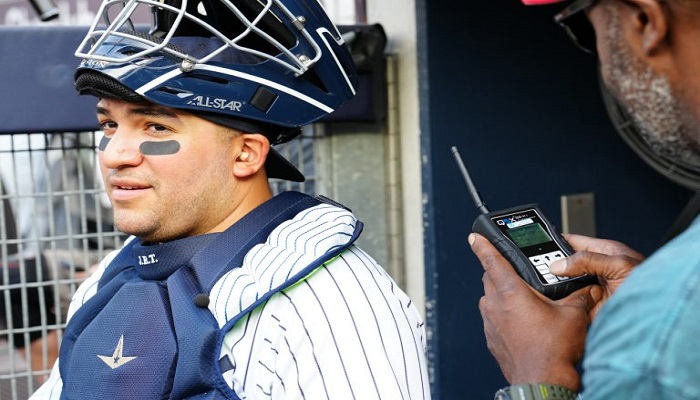Whether it’s advanced volumetric replays via Statcast, in-game conversations with players on the field, or unique collaborations with Major League Baseball, the ESPN Sunday Night Baseball crew is prepared to deliver even deeper insight and understanding into the game.
“People want experiences,” Karl Ravech, a veteran ESPN baseball commentator, said. “Our broadcast is an opportunity to provide the viewer with an experience they otherwise wouldn’t get.”
Here’s how ESPN and its announcing team of Ravech, David Cone, Eduardo Pérez, and on-field reporter Buster Olney are changing the way we watch the national pastime.
Game of Numbers
Baseball—maybe more than any other sport—lives off statistics.
The reliance on more nuanced, advanced, and up-to-the-minute metrics is increasingly becoming central to how games are managed, played, and even enjoyed by viewers.
“This is information that we just guessed at back when I pitched,” Cone, a former Cy Young winner, said.
Now, pitchers like New York Yankees starter “Gerrit Cole get a printout between innings to show exactly what his vertical and horizontal movements were on his pitches, where his release point was,” according to Cone.
While the data is important to teams, Ravech said that the crew’s “balancing act is how much information do you give, because some fans want that information while others just want to watch a dang game without it.”
The main factor that helps the crew decide on which data to highlight is “to look at the metrics that are driving the decision-making in the game,” according to Phil Orlins, ESPN VP of Production.
“We would not be doing our jobs if we weren’t trying to educate ourselves” on the advanced statistics being referenced, Cone added. “And trying to let the viewer know exactly how these decisions are made and what’s going on behind the scenes.”
ESPN is working to create advanced visualizations for viewers in real time as well.
Orlins explained that ESPN already provides alternate Statcast broadcasts on ESPN 2, and is looking to build on that technology by “using volumetric data-created replays that will allow you to see replays from any position on the field—in the batter’s helmet, behind the pitcher, over the shortstop’s shoulder.”
The Sunday Night team is working “to find effective and important usages for it in the ESPN show,” Orlins pointed out. He noted that incorporating more of those graphics into the main broadcast, “from a visual standpoint, it’s going to really differentiate those shows.”
A new featured metric that may cause a buzz is win probability, which Orlins plans on to have displayed on the mini board “98% of the time.”
“I think it just speaks to the way people think about sports right now,” he said.
“Get us inside a game”
Because of ESPN’s “Mic’d Up”, fans can even get inside the heads of the players and experience the game from field level.
“We expect to mic and talk to a player in just about every game,” said Orlins.
Andy Jacobson, Sunday Night Baseball Producer, noted that it helps to have great announcers since the team makes the players comfortable “not only during the interviews, but in the process leading up.”
“There is an E in ESPN, and it stands for entertainment,” said Ravech. “One of the great experiences we can provide is access to a player who’s playing a game.”
Pérez notes that players will say “it actually had me even more engaged in the game” when it comes to being ‘Mic’d Up.’
He added that players “like the aspect of being able to explain to the audience what I am doing out here… to be able to explain it to kids or to parents or to coaches what we’re doing in certain situations.”
As more players have gotten “Mic’d Up,” more have found that they’re enjoying the experience,” said Orlins.
“Guys are cooperative,” Orlins said. “Partly because of Eduardo, guys who speak foreign languages first or are uncomfortable with English are comfortable going on and being translated.”
Ravech added that it’s all in service of trying to “Get us inside a game. Get us an experience we otherwise aren’t going to get.”
Teaming Up
To gain that unique access, ESPN needed strong collaboration with both MLB and the MLB Players Association.
While many statistics are calculated by in-house teams at ESPN, the Statcast effort is a collaboration with the league.
Orlins contributes three distinct factors that have led to the success of “Mic’d Up”: “The league support, the Players Association support, and just as importantly the visibility and relationships of our broadcast team.”
For both MLB and the Players Association, their collaborations with ESPN have shown the sport in a new light.
Orlins points out that “Mic’d Up” has “positioned MLB as a pretty progressive sports league, which is not necessarily the perception of the sport before that.”
The same goes for the Players Association and the athletes: “They get that it shows them in a positive light. They’re a younger group of players that have online presences and have some degree of care about how they’re perceived or heard in the first person. They’ve really been a great supporter of it,” he said.
That allows for stars like Rafael Devers, third baseman for the Boston Red Sox and Corbin Carroll, the Rookie of the Year for the Arizona Diamondbacks, to both give insightful looks into how the game is played, and come out of their shells and show fans a different side of themselves.
“That’s the ultimate win when that happens,” Orlins said.
Source: Disney+


